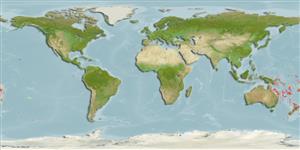Teleostei (teleosts) >
Acropomatiformes (Oceanic basses) >
Champsodontidae (Crocodile toothfishes)
Etymology: Champsodon: Greek, champso = crocodile, voracious predator + Greek, odous = teeth (Ref. 45335).
Environment: milieu / climate zone / depth range / distribution range
Ecology
Marine; bathydemersal; depth range 260 - 410 m (Ref. 30434). Deep-water
Southwest Pacific: Australia.
Size / Weight / Age
Maturity: Lm ? range ? - ? cm
Max length : 8.8 cm SL male/unsexed; (Ref. 30434)
Dorsal spines (total): 4 - 6; Dorsal soft rays (total): 18 - 23; Anal soft rays: 16 - 21. Chin scaly. A row of 4 pairs of sensory papillae between parallel bony ridges on dorsal surface of snout. Four sensory papillae between eyes arranged in semicircle. Ventral margin of pupil smooth, not indented by tab of iris (Ref 12850).
Life cycle and mating behavior
Maturity | Reproduction | Spawning | Eggs | Fecundity | Larvae
Nemeth, D., 1994. Systematics and distribution of fishes of the family Champsodontidae (Teleostei: Perciformes), with descriptions of three new species. Copeia 1994(2):347-371. (Ref. 30434)
IUCN Red List Status (Ref. 130435: Version 2024-1)
Threat to humans
Harmless
Human uses
Tools
Special reports
Download XML
Internet sources
Estimates based on models
Preferred temperature (Ref.
123201): 7 - 17.4, mean 12 °C (based on 33 cells).
Phylogenetic diversity index (Ref.
82804): PD
50 = 0.5002 [Uniqueness, from 0.5 = low to 2.0 = high].
Bayesian length-weight: a=0.00513 (0.00215 - 0.01225), b=3.02 (2.81 - 3.23), in cm total length, based on LWR estimates for this (Sub)family-body shape (Ref.
93245).
Trophic level (Ref.
69278): 4.0 ±0.5 se; based on size and trophs of closest relatives
Fishing Vulnerability (Ref.
59153): Low vulnerability (10 of 100).
